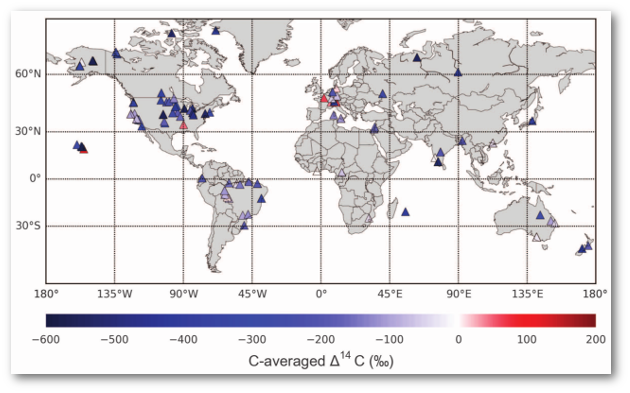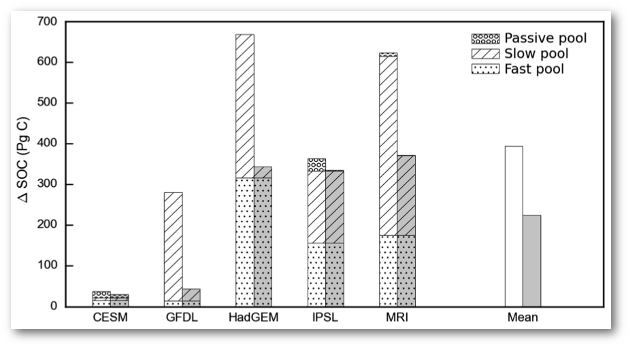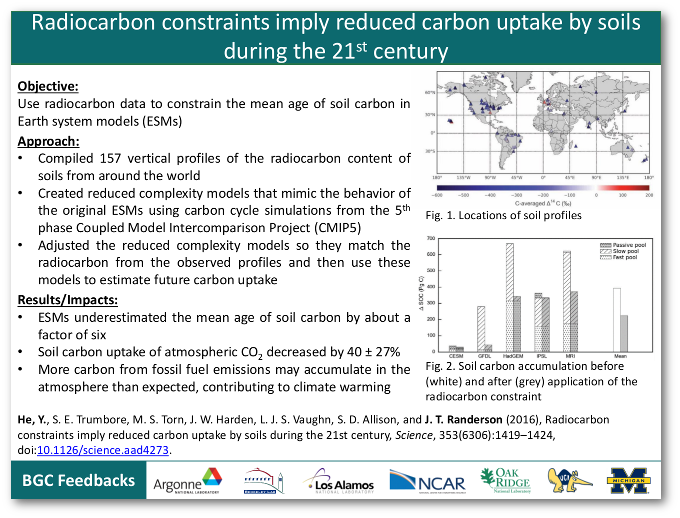Research Highlights
Radiocarbon constraints imply reduced carbon uptake by soils during the 21st century
September 22, 2016
Analysis of carbon isotope data suggests Earth system models overestimate soil carbon sequestration potential.
The Science
Researchers from the University of California Irvine, Germany's Max Planck Institute for Biogeochemistry, Lawrence Berkeley National Laboratory, and Stanford University/US Geological Survey used 14C isotope data from 157 globally distributed soil profiles to show that Earth system models (ESMs) from the fifth phase of the Coupled Model Intercomparison Project (CMIP5) underestimated the mean age of soil carbon by about a factor of six, resulting in an overestimate of soil carbon sequestration potential by a factor of nearly two. These findings, which have important implications for future atmospheric CO2 levels, emphasize the need to incorporate 14C and other tracer diagnostics into ESMs to improve the quality of future climate projections. The work also illustrates the potential value of systematically exploiting available ecosystem measurements during model development to create more robust models.
The Impact
Our analysis suggests that the carbon–concentration feedback may be weaker in the 21st century than currently expected from ESMs. Therefore, a greater fraction of CO2 emissions than previously thought could remain in the atmosphere and contribute to global warming.
Summary
Soil the largest terrestrial carbon reservoir and may influence the sign and magnitude of carbon cycle–climate feedbacks. Many Earth system models (ESMs) estimate a significant soil carbon sink by 2100, yet the underlying carbon dynamics determining this response have not been systematically tested against observations. We used 14C data from 157 globally distributed soil profiles sampled to 1-meter depth to show that ESMs underestimated the mean age of soil carbon by a factor of more than six (430 ± 50 years versus 3100 ± 1800 years). Consequently, ESMs overestimated the carbon sequestration potential of soils by a factor of nearly two (40 ± 27%). These inconsistencies suggest that ESMs must better represent carbon stabilization processes and the turnover time of slow and passive reservoirs when simulating future atmospheric carbon dioxide dynamics.
Objective
Use radiocarbon data to constrain the mean age of soil carbon in Earth system models (ESMs).
Approach
- Compiled 157 vertical profiles of the radiocarbon content of soils from around the world.
- Created reduced complexity models that mimic the behavior of the original ESMs using carbon cycle simulations from the 5th phase Coupled Model Intercomparison Project (CMIP5).
- Adjusted the reduced complexity models so they match the radiocarbon from the observed profiles and then use these models to estimate future carbon uptake.
 |
Figure 1: Locations of soil profiles. |
 |
Figure 2: Soil carbon accumulation before (white) and after (grey) application of the radiocarbon constraint. |
Results/Impacts
- ESMs underestimated the mean age of soil carbon by about a factor of six.
- Soil carbon uptake of atmospheric CO2 decreased by 40 ± 27%.
- More carbon from fossil fuel emissions may accumulate in the atmosphere than expected, contributing to climate warming.
He, Yujie, Susan E. Trumbore, Margaret S. Torn, Jennifer W. Harden, Lydia J.S. Vaughn, Steven D. Allison, and James T. Randerson. September 22, 2016. “Radiocarbon Constraints Imply Reduced Carbon Uptake by Soils during the 21st Century.” Science, 353(6306):1419–1424. doi:10.1126/science.aad4273.
